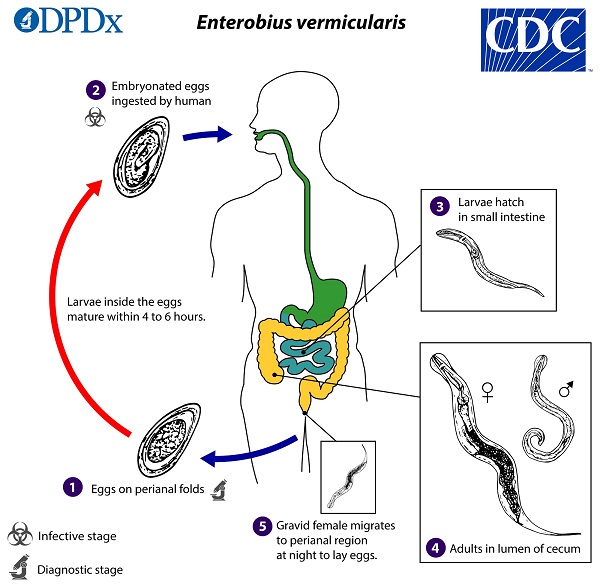Enterobius vermicularis - Life Cycle, Pathogenesis, Pathology, Host Immunity
Life Cycle of Enterobius vermicularis
The life cycle of Enterobius vermicularis is completed in the human gastrointestinal tract of a single host in about 2 to 4 weeks or 4 to 8 weeks. The parasitic larvae molt four times – the first two molts occur within the egg while the later two after hatching to become an adult pinworm.
Infection in humans begins with ingestion of viable embryonated eggs while swallowing of airborne eggs is rare
larvae of Enterobius vermicularis hatch in the host duodenum where they grow rapidly in size i.e. from 140 to 150 μm
from there they migrate to the colon-caecum and vermiform appendix
* During this migration, the parasite molts twice to become adults
they mature into adult pinworms within 15 to 30 days of infection – growing
after mating in the ileum, the male dies and is passed out with the stool
gravid female Enterobius vermicularis settle in the ileum, caecum, appendix, and ascending colon by attaching themselves to the mucosa
males live for about 7 weeks while females live for 5 to 13 weeks
the parasite feeds on host colonic contents as the entire body of the gravid female becomes filled with eggs
each female’s uteri may hold from 11,000 to 16,000 eggs and the egg laying begins approximately 5 weeks after infection
female Enterobius vermicularis, at the rate of 12 to 14 cm per hour, migrate from the colon to the rectum to emerge from the anus
sometimes the female parasite may emerge from the host anus to receive oxygen that is essential for the maturation of the eggs
on the perianal and peroneal skin around the host anus, the gravid female lays eggs by either dying and disintegrating, rupturing of female worm by the action of the host scratching the anus or by contracting and expelling the eggs
after the eggs have been deposited, the female becomes opaque and dies
these eggs can survive for up to three weeks in a suitable environment.
the Enterobius vermicularis eggs become embryonated and are infective 6 hours after being laid
these eggs may infect the same host through unhygienic practices (hand-to-mouth transfer) or to another host via anal-to-oral sex, or through infective beddings and linens

Life Cycle of Enterobius vermicularis (Source: CDC)
Pathogenesis, Pathology of Enterobius vermicularis
Pathogenicity of adult worms
Adult Enterobius vermicularis produces little pathological changes in the host intestine. In a sensitized host, absorption of worm metabolite excreta by the host can result in allergic manifestations.
Other pathological changes include mild catarrhal inflammation of the intestinal mucosa at the site of parasitic attachment and the development of minute ulcers in the caecum and appendix.
Pathogenicity of egg
The pathogenicity caused by Enterobius vermicularis eggs is much more serious and significant.
As the eggs adhere to the surface of the host skin with the help of mucoid secretions, it can cause irritation. This condition is termed nocturnal perianal or perineal itching.
Host Immunity of Enterobius vermicularis
Infection by Enterobius vermicularis is more common in children than in adults. Studies have reported that age-related immunity or acquired immunity against the parasite may develop as age progresses.